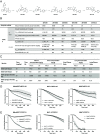Viruses traverse the human proteome through peptide interfaces that can be biomimetically leveraged for drug discovery
- PMID: 38252831
- PMCID: PMC10835127
- DOI: 10.1073/pnas.2308776121
Viruses traverse the human proteome through peptide interfaces that can be biomimetically leveraged for drug discovery
Abstract
We present a drug design strategy based on structural knowledge of protein-protein interfaces selected through virus-host coevolution and translated into highly potential small molecules. This approach is grounded on Vinland, the most comprehensive atlas of virus-human protein-protein interactions with annotation of interacting domains. From this inspiration, we identified small viral protein domains responsible for interaction with human proteins. These peptides form a library of new chemical entities used to screen for replication modulators of several pathogens. As a proof of concept, a peptide from a KSHV protein, identified as an inhibitor of influenza virus replication, was translated into a small molecule series with low nanomolar antiviral activity. By targeting the NEET proteins, these molecules turn out to be of therapeutic interest in a nonalcoholic steatohepatitis mouse model with kidney lesions. This study provides a biomimetic framework to design original chemistries targeting cellular proteins, with indications going far beyond infectious diseases.
Keywords: biomimetism; chemoinformatics; interactomics; kidney; viruses.
Conflict of interest statement
Competing interests statement:L.M.-S., P. Mallinjoud, R.D., J.V., and B.d.C. are working for ENYO Pharma. L. Lines, J.-L.P., S.J., D.S., and E.C.M. were working for ENYO Pharma. F.H., P. Machin, and I.M. were consultants for ENYO Pharma. J.V. is the CEO of ENYO Pharma. P.A. and V.L. are scientific advisors for ENYO Pharma. F.G. is working for Inventiva. J.A. was working for Inventiva.
Figures






References
-
- Scannell J. W., Blanckley A., Boldon H., Warrington B., Diagnosing the decline in pharmaceutical R&D efficiency. Nat. Rev. Drug Discov. 11, 191–200 (2012). - PubMed
-
- Ringel M. S., Scannell J. W., Baedeker M., Schulze U., Breaking Eroom’s law. Nat. Rev. Drug Discov. 19, 833–834 (2020). - PubMed
-
- Mullard A., 2020 FDA drug approvals. Nat. Rev. Drug Discov. 20, 85–90 (2021). - PubMed
-
- Davey N. E., Travé G., Gibson T. J., How viruses hijack cell regulation. Trends Biochem. Sci. 36, 159–69 (2011). - PubMed
MeSH terms
Substances
LinkOut - more resources
Full Text Sources
Medical
Research Materials

